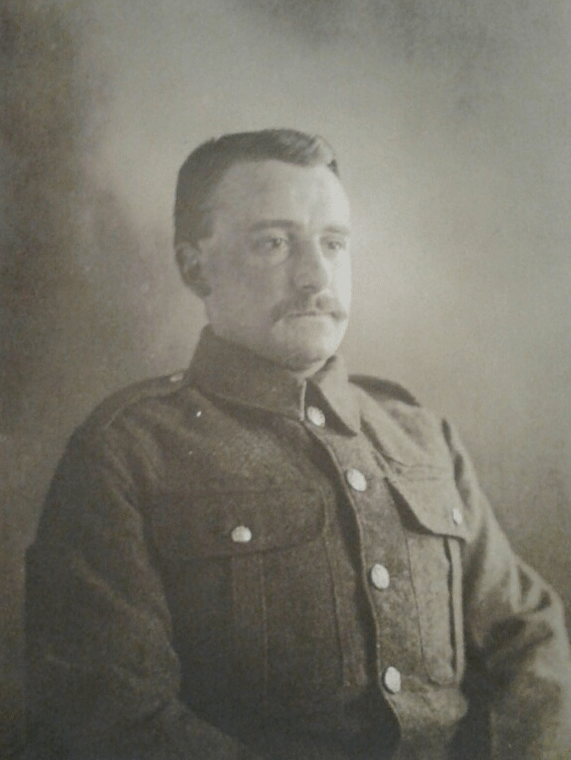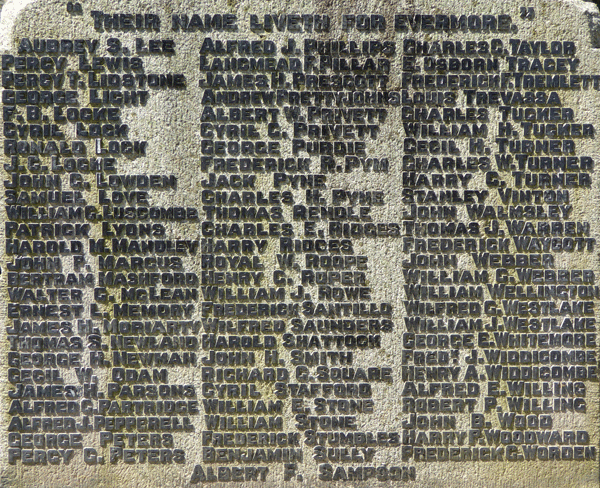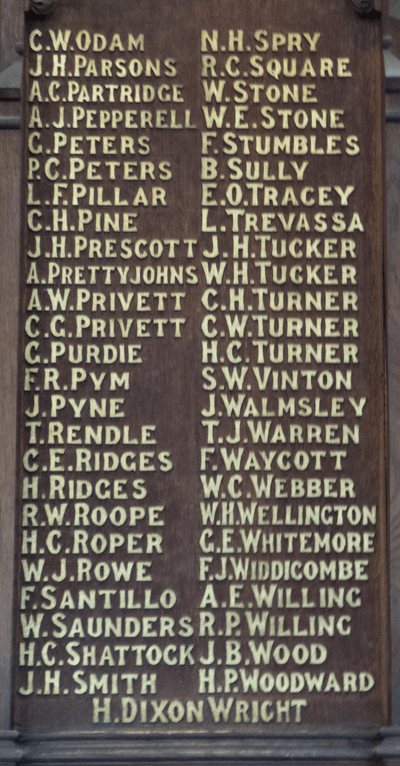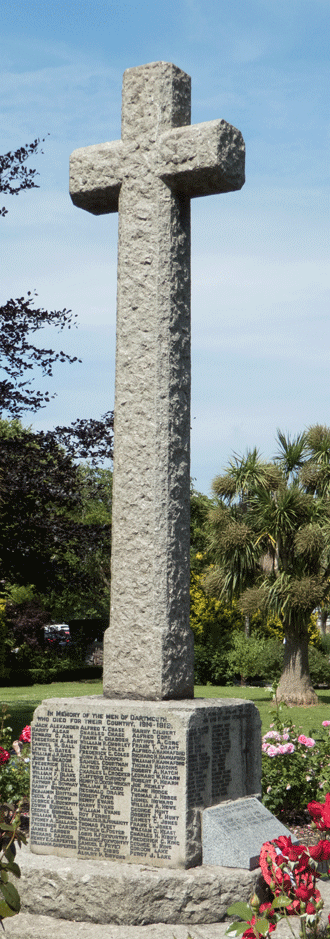Harold Claude Shattock
Harold Claude Shattock was not a native of Dartmouth but was born in Portland, Dorset. He was the son of Robert John Scott Shattock, who first came to Dartmouth to serve in HMS Britannia.
Family
Robert John Scott Shattock came from Stonehouse, Plymouth. He joined the Navy on 1st January 1873 as a Domestic 1st Class, and then on 15th August 1874 began a ten-year continuous service engagement as a Sick Berth Attendant. Shortly afterward he married Elizabeth Ann Reed, from Calstock, Cornwall. Robert and Elizabeth came to Dartmouth for the first time when he was appointed to HMS Britannia on 19th October 1874. Britannia was at that time the old training ship moored in the Dart.
According to the 1881 Census, the couple's eldest son, Arthur, was born in Stonehouse around 1874. Their second child, George Henry, was born in Dartmouth in 1875, and baptised in St Saviours on 30th May - at that time the family lived in Silver Street (now Undercliff). But they did not remain in Dartmouth for long. By 1877, the family was back in Plymouth, while Robert was away in the Mediterranean. Robert James was born in 1876; Ada Rose in 1879, after her father had returned to England; and William in 1881. Sadly, Robert James died in 1881, aged only four.
On 20th February 1882, Robert was once more appointed to HMS Britannia. This time, the family found a home in Clarence St. Their next child, Frederick, was born there on 1st February 1883; but only a couple of days later, Robert and Elizabeth were bereaved once more by William's death, aged about eighteen months. Their seventh child, Charles Ernest, was also born in Dartmouth, in 1884, but died just before his first birthday. Robert had already left HMS Britannia, and was once again serving in the Mediterranean, this time on HMS Invincible, first as Sick Berth Attendant, and then as Sick Berth Steward.
On 14th January 1886 Robert joined HMS Boscawen, the name given to the boys training establishment at Portland, and the family moved to Portland, where Harold Claude was born later that year. But on 29th April 1887, Robert died of pneumonia, aged only 37. Elizabeth was left to look after her surviving children alone; and she decided to return to Dartmouth. At the time of the 1891 Census she lived in South Ford Road with Frederick, aged 8, and Harold, aged 4, and working as a laundress. She had found a place for Ada, aged 11, at the Royal British Female Orphan Asylum in Devonport, which offered accommodation and suitable training for "female orphans of sailors, soldiers, and marines". The older boys had by this time followed their father to sea, Arthur working in merchant shipping, George in the Royal Navy. Records about Arthur are scarce, but George joined HMS Impregnable in Devonport as a Boy 2nd Class on 4th July 1890.
In 1893 Elizabeth married again, in Dartmouth. Her second husband was Frederick James Tucker Purdy, a carpenter and stonemason who worked in the building industry. He was born in the town, a widower aged 45, with an only daughter, Laura Blanche, born in 1876 (a son had died in infancy). In 1895, Elizabeth gave birth to her last child, William Charles Edwin Purdy, baptised at St Saviour's on 17th March 1895. Sadly the little boy died aged only ten weeks old. Elizabeth also lost her only daughter, Ada Rose, on 13th January 1895.
By the time of the 1901 Census, Frederick, Elizabeth and Harold lived in Clarence Hill. Harold was already, aged 14, described as a "Cabinet Maker". He was apprenticed to Robert Pillar, a builder, contractor and undertaker, in Dartmouth. Harold was the only one of Elizabeth's children still at home, as his older brother Frederick had joined the Navy as a Stoker in 1899.
On 8th October 1910, Harold married Hilda Louise Abraham, at St Clements Townstal. Hilda was born in 1887 in Lower Week, between Dartmouth and Stoke Fleming, where her father, William Finch Abraham, was a labourer. She was the eldest daughter of William and his wife Mary Ann Marks, married in St Peter's Stoke Fleming on 24th June 1886. By the time of the 1891 Census, William Abraham was working for the Brewery in Warfleet as a waggon driver. He and his family lived in Compass Cottages, Warfleet. By 1901, he had joined the Great Western Railway to work as a railway carman, and he continued to work for the railway until he retired.
Hilda and Harold began their married life in three rooms within Pretoria Cottage, the home of his mother and stepfather, in Victoria Road. In the 1911 Census Harold was recorded as a Joiner in the house building industry. The couple's daughter Elsie May was born soon after the Census was taken, and she was baptised at St Saviours on 6th July 1911. A son, Harold John, followed in September 1914, also baptised at St Saviours, on 19th November 1914. By this time, Harold and Hilda had moved to 3 Weybourne Terrace, Ford Valley. Harold meanwhile had left the house building industry and taken his skills to the Works Department at the Royal Naval College Dartmouth.
Apart from his family and his work, Harold was a keen member of the Dartmouth Amateur Swimming Club - at the time of his death, he was the honorary secretary. In 1906 the Club had obtained permission from the War Office to use Castle Cove, just below Dartmouth Castle, as a location for their activities, and was allowed to build various facilities there. Because of his involvement with the Swimming Club, Harold became well-known and well-liked in Dartmouth.
Service
Unusually, Harold's service papers have survived, so we know he enlisted in the Royal Engineers at Dartmouth, on 29th January 1915, as a Sapper, with the qualification of "Skilled Carpenter". Four days beforehand, he had received a glowing reference from Mr W Grey, Admiralty Foreman of Works at the Royal Naval College, who was sorry to see him go:
This is to certify that Harold Claude Shattock has been employed under me in the Admiralty Director of Works Department, at the Royal Naval College Dartmouth, during which time he has proved himself a most able and efficient Carpenter and Joiner, and I am sorry to part with his services. He is leaving, owing to the war, to join H M Forces.

Photo courtesy of his grandson Dave
On 5th February 1915, Harold was posted to No 1 Section 126th Field Company Royal Engineers. The War Diary of this unit begins with their embarkation to France on 11th September 1915 at Milford. On board the train to Southampton and the ship to Le Havre were 6 officers, 226 other ranks, including Harold, 81 horses, 11 four-wheel vehicles and 4 two-wheel vehicles. 126th Field Company was part of 21st Division, and Harold, newly promoted Lance Corporal on 18th September 1915, found himself heading for the offensive at Loos.
The Field Company's job was not fighting (though sometimes men found themselves doing that) but construction - building the infrastructure essential to sustain and support every aspect of the fighting effort, and also building defensive works and "strong points" in the field.
On 23rd September, at Les Presses they were briefed by General Gloster on "intended operations". They "made several types [of] trench bridge". The following day, they were briefed by General Hakin on "full details of operations", presumably referring to the forthcoming battle. The move up to Loos was accompanied by some attempts at secrecy - "cyclists [were] posted in daylight at doubtful points on the route [with] their caps covered with white paper". They were to remain in position until the motor vehicles have passed. Troops and transport were to be concealed during the day".
At 6.30pm on 25th September, as the battle began, they marched through Mazingarbe. "On the Infantry deploying, Company advanced in rear of Brigade. A few men were sent forward to remove wire etc. All transport had to be sent on by road to Loos. All tools had to be carried. Considerable work entailed in filling up trenches to allow passage of SAA [small arms ammunition] mules".
21st and 24th Divisions were sent into the battle on 26th September, but sustained heavy losses, and the attacks failed. Behind the infantry, 126th Field company occupied the old British front line trench at 2.30am on that day, half of No 4 section remaining in the rear with Brigade Headquarters. At 11.30am, shelling was "very severe", both high explosive and gas, and the company sustained its first casualties; two officers were gassed, one wounded, and also one sapper wounded. Subsequently Sapper Ernest Wilbeforce Auger died on 18th February 1916 at Etaples of wounds received near Loos. For a general account of the battle (with a focus on men from Dartmouth) see our article here.
Oddly, there seems to be no report in 126th Field Company's Diary for 27th - 30th September 1915, but on 1st October 1915 they were withdrawn from the battlefield, and moved to billets; Bosseghem that night and Fletre the following night. On 3rd October 1915, the Diary states that "men [were] dismissed and given the day for bathing. Sappers employed on making baths for the sections". Several days passed in drill and instruction. On 10th October 1915 they moved to Armentières, and the following day Harold was admitted to 75 Field Ambulance for "abdominal pains". He returned to duty two days later, by which time one of the Company's sections was employed on the defences of Armentières (a significant logistical base for the front) and three on the subsidiary line. The Company worked on the defences of Armentières for a month. On 12th November 1915 they moved forward to work on communication trenches, and Sapper John Cameron Mackenzie (apparently their first death) was killed by a rifle shot.
On 13th November they took over "sector Pont Ballot Farm -River Lys from 7th Field Company. This includes all works back to but not including subsidiary line". It was very wet. The whole company was "employed repairing damage done by rain in Front and Communication trenches". For the whole of the rest of November, December, January and February they worked on the front, support and communication trenches in this sector, in fairly unpleasant conditions. The weather continued wet and got colder and colder. The town was heavily shelled from time to time. On 11th December the River Lys was in flood and their billets in Rue de Flandres were flooded. The War Diary is brief, but does record that on 25th December, they stopped work at 2pm (presumably for some sort of Christmas celebration).
Though they may not themselves have been fighting, their tours in the trenches nevertheless saw casualties. During this period several men were wounded, and the Company suffered four deaths - one officer, one senior NCO and two sappers:
- Sapper John Grainger, on 18th December, killed while "putting up a screen" in a trench.
- Sapper Ernest John Arthurs, killed on 28th December.
- Second Lt Charles Stuart Lee, aged 19, who reported for duty on Christmas Eve and was killed six days later, on 30th December, during a bombardment of the trenches.
- On 14th January, Company Sergeant Major Frederick Samuel Spreadborough was "drowned whilst trying to save [a] Belgian child who had fallen into [the river] Lys".
On 28th January, the War Diary noted that it was the Kaiser's birthday but "everything [was] very quiet". However, the following day the "whole of centre and left sector [was] subjected to worst bombardment yet experienced" by "large trench mortar bombs and aerial torpedoes". Several sections of trench were completely destroyed; Sapper A A Larner was killed and two others were wounded. Nos 3 and 4 sections worked on repairs all night.
On 1st February, the front on which they were working was extended to L'Epinette. For February and March they worked on front line, support and fire trenches. The area continued to be shelled. 2nd Corpl John William Goulding was wounded on 8th February and died at Etaples, on 17th February. On 26th February Serjeant Richard Stibbs and Sapper W A Flowers were both killed.
March was largely quiet, with quite a lot of snow. On 10th March, Harold was promoted 2nd Corporal. On 22nd/23rd March, they packed up and moved to a rest area not far away at Clapbanck, south west of Bailleul. The following day nos 1 and 2 sections were put to work on the divisional baths, while 3 and 4 sections carried out "Rifle Drill etc". The whole Company was inspected by Sir Douglas Haig in the afternoon. On 26th March the Company had a day off - after Church Parade. More time was spent working on the baths and yet another dignitary, General Plumer, commanding Second Army, came to inspect them.
This routine changed at the end of March, when they were ordered to the Somme. At 2.20am on 31st March 1916 they left for Godewaersvelde station, and arrived at Longeau station, south east of Amiens, at 6.45 pm. They then carried on by road to their billets in Bonnay. After a few days rest, drill and route marching, in "fine, very warm" weather (evidently a contrast from the snowstorms in Flanders) they arrived in the trenches near Méaulte, just south of Albert, on 10th April. There, they began work, as before, on the "fire, support, front line trenches and dugouts". (The 9th Devons had been in Méaulte two months previously - see the story of Robert Phillips Willing).
The rest of April and the first few days of May were (apparently) largely uneventful. Méaulte was shelled on 15th and 18th April and 1st and 3rd May, and on 30th April there was "hostile gas" between 7.45 - 9.00pm. On 4th May, the company's billet was shelled, and three men were wounded. Sapper Francis Whicher Greenaway was evidently taken to no 21 Casualty Clearing Station as he died later that day and was buried at La Neuville Cemetery, Corbie. The rest of the month was quiet, with only a "few shells" reported on 13th May.
The diary continues in similar vein in June. The company continued "at work on front line, fire and support trenches". From time to time Méaulte was shelled and on 5th June, Driver P T Cossham was killed. On 22nd/23rd June, the company moved to Ville-sur-Ancre, slightly further south, where they prepared for the forthcoming attack.
Action on 1st July 1916
The Company sappers left Ville at 4am and marched to RE Dugouts in Becourt Valley, arriving at 7.30am, just as the infantry "went over the top" (the HQ section and the transport were left at Ville). The 21st Division attacked on the Somme between the Albert-Bapaume Road and Fricourt. The four sections of 126 Field Company "proceeded into action at 8.30am to construct strong points and consolidate positions gained by the infantry".
A more detailed account of the Company's action, included as an appendix in the War Diary, states that three sections, together with men from the 13th and 14th Battalions of the Northumberland Fusiliers, spent the daylight hours of 1st July 1916 in dugouts while Captain Dewing went off to get orders, owing to telephone lines having been cut. He returned at 7.00pm. At 8.35pm, they went out to construct various "strong points" at specific positions, as ordered. One of the Field Company sections was unable to build their strong point because the position was in enemy hands, but nonetheless built one elsewhere which was "defensible and wired all round" by 3.30am. The second section arrived at their desired position by 1.30am and, assisted by the third section, was able to build two machine gun emplacements and improve five fire bays, with wire around two sides, before returning to the Becourt Valley. The third section was unable to build their planned strong point because it too was in enemy hands and so assisted the second section.
The following night all four Company sections returned to continue the work that had been begun and, if possible, to start the strong points they had not been able to build. Work on two was completed successfully; the third was constructed in a different position because the planned point was still in enemy hands; the fourth was able to complete "two machine gun emplacements and fire bays for 30 men with wire on north and east sides" but "was considerably hampered by our own artillery which was enfilading the trench running nearly north -south on the west side of Round Wood". In the meantime Company transport took material, stores and rations to trenches.
It is rather a surprise to read that in any unit in action on 1st July on the Somme, even one following the infantry, casualties were slight. The War Diary lists one man killed and six wounded on 1st/2nd July, but Commonwealth War Graves Commission records however show no deaths for the unit on that date. We don't know whether Harold's section was one of the three in action on 1st July, but presumably he was involved on 2nd July, since all four sections were in action on that day.
In the early morning of 3rd July, all parties returned to Becourt Valley by 3.00am. At 6.54am, they went by train from Dernancourt to Ailly, and by road to billets at Picquigny and thence to Fourdrinoy, for (presumably much needed) showers. On 10th July they did the journey in reverse, arriving back at the dugouts in the Becourt Valley on 11th July.
Death
The next phase of the Somme offensive was to push forward the attack in the south, where there had been some success, to attempt to break through the German Second Line. Prior to the main attack, preliminary attacks were made on several targets. On 10th July, the 38th Division attacked Mametz Wood, north of the village of Mametz. For an account of this action, see the story of George Henry King. When the 38th Division was withdrawn after the attack, it was replaced by 21st Division, who had to finish the job of clearing the wood and pushing the front line forward for the attack on the Bazentin Ridge planned for 14th July. It is evident from all accounts of the intense fighting in and for Mametz Wood that Harold must have found himself in very difficult conditions.
The War Diary states that on 12th July, "Company Sappers, under Capt R E Dewing and Section Officers proceeded into action to make strong points and consolidate positions in Mametz Wood", and reports casualties as follows: killed OR6, wounded 2nd Lt W J Moffatt, OR 26, shell shock OR1".
No further detail is provided, but Harold's service papers record that he was killed in action on 12th July.
On 28th July 1916 the following annoucement appeared in the Dartmouth Chronicle:
Shattock - Killed on active service in France, July 12th, 2nd Corpl Harold Claude Shattock, RE, the dearly beloved husband of Hilda Louisa Shattock, 3 Weybourne Terrace, Dartmouth, age 30. Sadly missed by his sorrowing wife and little children.
A further short piece reported that:
Information has been received by Mrs Shattock 3 Weybourne Terrace Ford Valley Dartmouth that her husband, Lce Corpl H C Shattock, has been killed at the Front. Lce Corpl. Shattock, who was serving with the Royal Engineers, was up till the time of his death the honorary secretary of the Dartmouth Amateur Swimming Club. The committee of the club are meeting tonight and will receive the sad tidings of the death of their popular secretary with great regret. The late lance-corporal, who was a carpenter by trade, was apprenticed to Mr Robert Pillar. He leaves a wife and two young children with whom the greatest sympathy is felt.
The following week the paper reported on the Swimming Club's meeting:
At a meeting of the Dartmouth Amateur Swimming Club on Friday ... the chairman reported with deep regret that their esteemed secretary (Lance Corporal H C Shattock) had been killed in action on the battlefield in France, and said that by the death of their secretary they had lost one who took the greatest interest in the welfare of the club, and their heartfelt sympathies went out to the widow and two children in their sad and irreparable loss. The late secretary had always been keen in doing what he could to promote swimming, and when at a game of polo he always proved himself to be a good "sport" whether winning or losing.
A resolution expressing sympathy with the widow and family was carried in silence, all present standing in their places.
The club launched an appeal to raise funds for "a tangible recognition of his valuable services to the club" in the form of a monetary gift to Hilda and the children.
Commemoration
Harold is commemorated on the Thiepval Memorial, one of more than 72000 officers and men of the United Kingdom and South African forces who died in the Somme sector before 20 March 1918 and have no known grave.
Though the 126th Field Company War Diary reported six deaths on 12th July, Commonwealth War Grave Commission records show nine other deaths from 126th Field Company on that day, six of whom are also on the Thiepval Memorial with Harold:
| L/Cpl John Edwin Ransby | Thiepval |
| Sapper Robert G Chick | Thiepval |
| Sapper Samuel George Downing | Thiepval |
| Sapper Frederick G Collins | Thiepval |
| Sapper Leonard Thomas Waterman | Thiepval |
| Sapper Leonard Pantling | Thiepval |
| Private J Gallagher | Caterpillar Valley, Longueval |
| Sapper W H Speak | Caterpillar Valley, Longueval |
| Sapper Herbert James Dunn | London Cemetery, Longueval |
In Dartmouth, Harold is commemorated on the Town War Memorial and the St Saviours War Memorial Board.


His name also appears on a Roll of Honour prepared by W Grey, Foreman of Works at the Royal Naval College, showing all the employees of the Works Department who had served in the Great War. The Roll of Honour is now in Dartmouth Museum.
Sources
The Naval Service Records of Robert John Scott Shattock, George Henry Shattock and Frederick Alfred Thomas Shattock are available for download from the National Archives, fee payable, references:
- Robert Shattock: ADM 188/21/49854
- George Henry Shattock: ADM 188/227/156351
- Frederick Alfred Shattock: ADM 188/473/293261
The War Diary of 126th Field Company is also available for download at the National Archives, fee payable, reference WO 95/2144/3
The Somme, by Peter Hart, publ Cassell, 2006
Information Held on Database
| Surname: | Shattock |
| Forenames: | Harold Claude |
| Rank: | 2nd Corporal |
| Service Number: | 65626 |
| Military Unit: | 126th Field Company, Royal Engineers |
| Date of Death: | 12 Jul 1916 |
| Age at Death: | 30 |
| Cause of Death: | Killed in action |
| Action Resulting in Death: | Battle of the Somme |
| Place of Death: | Mametz Wood |
| Place of Burial: | Commemorated Thiepval Memorial, France |
| Born or Lived in Dartmouth? | Yes |
| On Dartmouth War Memorial? | Yes |
| On St Saviour's Memorials? | Yes |
| On St Petrox Memorials? | No |
| On Flavel Church Memorials? | No |
| In Longcross Cemetery? | No |
| In St Clement's Churchyard? | No |
| On a Private Memorial? | No |
| On Another Memorial? | No |















